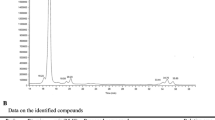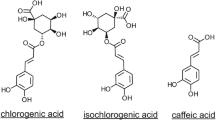Abstract
The effects of drought stress in autumn-growing Chinese cabbage cultivar on bioactive compounds, total antioxidant and binding properties to human serum albumin (HSA) were studied. Seedlings of 42 days growing Chinese cabbage Brassica rapa L. ssp. pekinensis cv. Bulam Plus (BRARP) were transplanted and maintained into pots during 3 weeks with soil water of the drought-treated (D-T) and control (C) plants at 10% and 30%, respectively. Polyphenols and the values of antioxidant capacities by three radical scavenging assays (CUPRAC, FRAP, ABTS) were determined in methanol extracts of the samples. MS spectra of phenolic extracts were compared in samples treated at different periods of time. The total polyphenols and their activities were slightly lower in drought-treated Chinese cabbage than in corresponding controls. The influence of polyphenols, total antioxidant and binding activities in D-T plants accumulation at drought stress in Chinese cabbage BRARP was reduced. Our study provides valuable information that Chinese cabbage BRARP can be consumed throughout the year in South Korea and other countries.



Similar content being viewed by others
Abbreviations
- ABTS:
-
2,2-Azino-bis (3-ethyl-benzothiazoline-6-sulfonic acid) diammonium salt
- BRARP:
-
Chinese cabbage Brassica rapa L. ssp. pekinensis cv. Bulam Plus
- C:
-
Control
- CUPRAC:
-
Cupric reducing antioxidant capacity
- D-T:
-
Drought-treated
- DPPH:
-
1,1 Diphenyl-2-picrylhydrazyl radical
- DW:
-
Dry weight
- FTIR:
-
Fourier transform infrared spectroscopy
- FRAP:
-
Ferric-reducing/antioxidant power
- FW:
-
Fresh weight
- HSA:
-
Human serum albumin
- GAE:
-
Gallic acid equivalent
- GL:
-
Glucosinolates
- MS:
-
Mass spectra
- ROS:
-
Reactive oxygen species
- ORAC:
-
Oxygen radical absorbance capacity
- TACs:
-
Total antioxidant capacities
- TPC:
-
Total phenolic content
- TFC:
-
Total flavonoid contents
References
Kim JH, Jung YA, Song BY, Bong YS, Ryu DH, Lee KS, Hwang GS (2013) Discrimination of cabbage (Brassica rapa ssp. pekinensis) cultivars grown in different geographical areas using 1H NMR-based metabolomics. Food Chem 137:68–75. https://doi.org/10.1016/j.foodchem.2012.10.012
Francisco M, Tortosa M, Martinez-Ballesta MD, Velasco P, Garcia-Viguera C, Moreno DA (2017) Nutritional and phytochemical value of Brassica crops from the agri-food perspective. Ann Appl Biol 170:273–285. https://doi.org/10.1111/aab.12318
Sivakumar D, Chen LY, Sultanbawa Y (2018) A comprehensive review on beneficial dietary phytochemicals in common traditional Southern African leafy vegetables. Food Sci Nutr 6:714–727. https://doi.org/10.1002/fsn3.643
Lee DS, Jeon DS, Park SG, Arasu MV, Al-Dhabi NA, Kim SC, Kim SJ (2015) Effect of cold storage on the contents of glucosinolates in Chinese cabbage (Brassica rapa L. ssp. pekinensis). South Indian J Biol Sci 1:38–42
Kusznierewicz B, Bartoszek A, Wolska L, Drzewiecki J, Gorinstein S, Namiesnik J (2008) Partial characterization of white cabbages (Brassica oleracea var. capitata f. alba) from different regions by glucosinolates, bioactive compounds, total antioxidant activities and proteins. LWT Food Sci Technol 41:1–9. https://doi.org/10.1016/j.lwt.2007.02.007
Baek SA, Jung YH, Lim SH, Park SU, Kim JK (2016) Metabolic profiling in Chinese cabbage (Brassica rapa L. subsp pekinensis). Cultivars reveal that glucosinolate content is correlated with carotenoid content. J Agric Food Chem 64:4426–4434. https://doi.org/10.1021/acs.jafc.6b01323
Wang N, Shen L, Qiu S, Wang X, Wang K, Hao J, Xu M (2010) Analysis of the isothiocyanates present in three Chinese Brassica vegetable seeds and their potential anticancer bioactivities. Eur Food Res Technol 231:951–958. https://doi.org/10.1007/s00217-010-1348-x
Herr I, Büchler MW (2010) Dietary constituents of broccoli and other cruciferous vegetables: implications for prevention and therapy of cancer. Cancer Treat Rev 36:377–383. https://doi.org/10.1016/j.ctrv.2010.01.002
Wu X, Beecher GR, Holden JM, Haytowitz DB, Gebhardt SE, Prior RL (2004) Lipophilic and hydrophilic antioxidant capacities of common foods in the United States. J Agric Food Chem 52:4026–4037. https://doi.org/10.1021/jf049696w
Rubab M, Chellia R, Saravanakumar K, Mandava S, Khan I, Tango CN, Hussain MS, Daliri EBM, Kim SH, Ramakrishnan SR, Wang MH, Lee JK, Kwon JH, Chandrashekar S, Oh DH (2018) Preservative effect of Chinese cabbage (Brassica rapa subsp pekinensis) extract on their molecular docking, antioxidant and antimicrobial properties. PLoS One 13:e0203306. https://doi.org/10.1371/journal.pone.0203306
Seong GU, Hwang IW, Chung SK (2016) Antioxidant capacities and polyphenolics of Chinese cabbage (Brassica rapa L. ssp pekinensis) leaves. Food Chem 199:612–618. https://doi.org/10.1016/j.foodchem.2015.12.066
Park SY, Jang HL, Lee JH, Choi Y, Kim H, Hwang J, Seo D, Kim S, Nam JS (2017) Changes in the phenolic compounds and antioxidant activities of mustard leaf ( Brassica juncea) kimchi extracts during different fermentation periods. Food Sci Biotechnol 26:105–112. https://doi.org/10.1007/s10068-017-0014-5
Vallejo F, Tomás-Barberán FA, Garcia-Viguera C (2002) Glucosinolates and vitamin C content in edible parts of Broccoli florets after domestic cooking. Eur Food Res Technol 215:310–316. https://doi.org/10.1007/s00217-002-0560-8
Ramos dos Reis LC, de Oliveira VR, Hagen MEK, Jabonski A, Flores SH, de Oliveira Rios A (2015) Carotenoids, flavonoids, chlorophylls, phenolic compounds and antioxidant activity in fresh and cooked broccoli (Brassica oleracea var. Avenger) and cauliflower (Brassica oleracea var. Alphina F1). LWT Food Sci Technol 63:177–183. https://doi.org/10.1016/j.lwt.2015.03.089
Tabart J, Pincemail J, Kevers C, Defraigne JO, Dommes J (2018) Processing effects on antioxidant, glucosinolate, and sulforaphane contents in broccoli and red cabbage. Eur Food Res Technol 244:2085–2094. https://doi.org/10.1007/s00217-018-3126-0
Gorinstein S, Park YS, Heo BG, Namiesnik J, Leontowicz H, Leontowicz M, Ham KS, Cho JY, Kang SG (2009) A comparative study of phenolic compounds and antioxidant and antiproliferative activities in frequently consumed raw vegetables. Eur Food Res Technol 228:903–911. https://doi.org/10.1007/s00217-008-1003-y
Lee MK, Arasu MV, Park S, Byeon DH, Chung SO, Park SU, Lim YP, Kim SJ (2016) LED Lights enhance metabolites and antioxidants in Chinese cabbage and kale. Braz Arch Biol Technol 59:e16150546. https://doi.org/10.1590/1678-4324-2016150546
Bae JH, Park YJ, Namiesnik J, Gulcin I, Kim TC, Kim HC, Heo BG, Gorinstein S, Ku YG (2016) Effects of artificial lighting on bioactivity of sweet red pepper (Capsicum annuum L.). Intern J Food Sci Technol 51:1378–1385. https://doi.org/10.1111/ijfs.13116
Francisco M, Moreno DA, Cartea ME, Ferreres F, Garcia-Viguera C, Velasco P (2009) Simultaneous identification of glucosinolates and phenolic compounds in a representative collection of vegetables Brassica rapa. J Chromatogr A 1216:6611–6619. https://doi.org/10.1016/j.chroma.2009.07.055
Lee H, Oh IN, Kim J, Jung DH, Cuong NP, Kim Y, Lee J, Kwon O, Park SU, Lim Y, Kim B, Park JT (2018) Phenolic compound profiles and their seasonal variations in new red phenotype head-forming Chinese cabbages. LWT Food Sci Technol 90:433–439. https://doi.org/10.1016/j.lwt.2017.12.056
Yu S, Zhang F, Yu Y, Zhang D, Zhao X, Wang W (2012) Transcriptome profiling of dehydration stress in the Chinese cabbage (Brassica rapa L. ssp. pekinensis) by tag sequencing. Plant Mol Biol Rep 30:17–28. https://doi.org/10.1007/s11105-011-0313-6
Shawon RA, Kang BS, Kim HC, Lee SG, Kim SK, Lee HJ, Bae JH, Ku YG (2018) Changes in free amino acid, carotenoid, and proline content in Chinese cabbage (Brassica rapa subsp. Pekinensis) in response to drought stress. Korean J Plant Res 31:622–633. https://doi.org/10.7732/kjpr.2018.31.6.622
Ku YG, Kang DH, Lee CK, Lee SY, Ryu CS, Kim DE, Polovka M, Namieśnik J, Gorinstein S (2018) Influence of different cultivation systems on bioactivity of asparagus. Food Chem 244:349–358. https://doi.org/10.1016/j.foodchem.2017.10.044
Apak R, Guclu K, Ozyurek M, Karademir SE (2004) Novel total antioxidant capacity index for dietary polyphenols and vitamins C and E, using their cupric ion reducing capability in the presence of neocuproine: CUPRAC method. J Agric Food Chem 52:7970–7981. https://doi.org/10.1021/jf048741x
Re R, Pellegrini N, Proteggente A, Pannala A, Yang M, Rice-Evans C (1999) Antioxidant activity applying an improved ABTS radical cation decolorization assay. Free Radic Biol Med 26:1231–1237. https://doi.org/10.1016/S0891-5849(98)00315-3
Benzie IFF, Strain JJ (1996) The ferric reducing ability of plasma (FRAP) as a measure of antioxidant power: the FRAP assay. Anal Biochem 239:70–76. https://doi.org/10.1006/abio.1996.0292
Singleton VL, Orthofer R, Lamuela-Raventos RM (1999) Analysis of total phenols and other oxidation substrates and antioxidants by means of Folin–Ciocalteu reagent. Methods Enzymol 299:152–178. https://doi.org/10.1016/S0076-6879(99)99017-1
Cozzolino D (2015) Infrared spectroscopy as a versatile analytical tool for the quantitative determination of antioxidants in agricultural products, foods and plants. Antioxidants 4:482–497. https://doi.org/10.3390/antiox4030482
Larkin PJ (2018) Infrared and Raman spectroscopy: principles and spectral interpretation, 2nd edn. Elsevier, Amsterdam
Sroka Z, Cisowski W (2003) Hydrogen peroxide scavenging, antioxidant and anti-radical activity of some phenolic acids. Food Chem Toxicol 41:753–758. https://doi.org/10.1016/S0278-6915(02)00329-0
Li ZF, Lee HW, Liang X, Liang D, Wang Q, Huang DJ, Ong CN (2018) Profiling of phenolic compounds and antioxidant activity of 12 cruciferous vegetables. Molecules 23:1139. https://doi.org/10.3390/molecules23051139
Heimler D, Vignolini P, Dini MG, Vincieri FF, Romani A (2006) Antiradical activity and polyphenol composition of local Brassicaceae edible varieties. Food Chem 99:464–469. https://doi.org/10.1016/j.foodchem.2005.07.057
Isabelle M, Lee BL, Lim MT, Koh WP, Huang D, Ong CN (2010) Antioxidant activity and profiles of common vegetables in Singapore. Food Chem 120:993–1003. https://doi.org/10.1016/j.foodchem.2009.11.038
Karnes HT, Shiu G, Shah VP (1991) Validation of bioanalytical methods (review). Pharm Res 8:421–426
Lee SG, Lee HJ, Kim SK, Choi CS, Park ST, Jang YA, Do KR (2015) Effects of vernalization, temperature, and soil drying periods on the growth and yield of Chinese cabbage. Korean J Hortic Sci Technol 33:820–828
Leontowicz H, Leontowicz M, Latocha P, Jesion I, Park Y-S, Katrich E, Barasch D, Nemirovski A, Gorinstein S (2016) Bioactivity and nutritional properties of hardy kiwi fruit Actinidia arguta in comparison with Actinidia deliciosa ‘Hayward’ and Actinidia eriantha ‘Bidan’. Food Chem 196:281–291. https://doi.org/10.1016/j.foodchem.2015.08.127
Cheng J, Dai F, Zhou B, Yang L, Liu ZL (2007) Antioxidant activity of hydroxycinnamic acid derivatives in human low density lipoprotein: mechanism and structure–activity relationship. Food Chem 104:132–139. https://doi.org/10.1016/j.foodchem.2006.11.012
Sinisi V, Forzato C, Cefarin N, Navarini L, Berti F (2015) Interaction of chlorogenic acids and quinides from coffee with human serum albumin. Food Chem 168:332–340. https://doi.org/10.1016/j.foodchem.2014.07.080
Acknowledgements
This research was supported by the Wonkwang University Research Grants in 2017. The authors are thankful to Dr. Elena Katrich (School of Pharmacy, Hebrew University of Jerusalem) for her technical assistance in determination of antioxidant status in Chinese cabbage.
Author information
Authors and Affiliations
Corresponding author
Ethics declarations
Conflict of interest
The authors declare that they have no conflict of interest.
Compliance with ethics requirements
All authors declare that this article does not contain any studies with human or animal subjects.
Additional information
Publisher's Note
Springer Nature remains neutral with regard to jurisdictional claims in published maps and institutional affiliations.
Rights and permissions
About this article
Cite this article
Ku, Y.G., Kim, H.C., Bae, J.H. et al. Antioxidant capacities and polyphenols in autumn-growing cultivar of Chinese cabbage (Brassica rapa L. ssp. pekinensis cv. Bulam Plus). Eur Food Res Technol 245, 1871–1879 (2019). https://doi.org/10.1007/s00217-019-03294-0
Received:
Revised:
Accepted:
Published:
Issue Date:
DOI: https://doi.org/10.1007/s00217-019-03294-0




